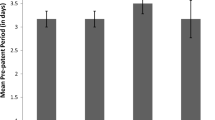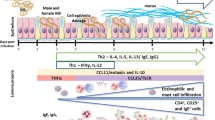Abstract
The effects of an infection with 200Trichinella spiralis larvae on the intestinal phospholipase B activity and bone marrow eosinophilia of congenitally athymic (nude) mice (BALB/c; NU/NU) were studied. Nude mice were used since it had been shown that they do not undergo a typical worm expulsion and also they lack a thymus. The results showed that nude mice do not develop either an increased bone marrow eosinophilia or an elevation in intestinal phospholipase B activity. The findings thus support the hypothesis that phospholipase B is involved in the expulsion of parasitic worms and that elevated enzyme levels and expulsion are thymus cell dependent.
Similar content being viewed by others
References
Colley, D.G.: Eosinophils and immune mechanisms. I. Eosinophil stimulation promotor (ESP); a lymphokine induced by specific antigen or phytohemagglutinin. J. Immunol.110, 1419–1423 (1973)
Larsh, J.E., Jr., Kent, D.E.: The effects of alcohol on natural and acquired immunity of mice to infection withTrichinella spiralis. J. Parasitol.35, 45–53 (1949)
Larsh, J.E., Jr., Race, G.J.: Allergic inflammation as a hypothesis for the expulsion of worms from tissues: A review. Exp. Parasitol.37, 251–266 (1975)
Larsh, J.E., Jr., Ottolenghi, A., Weatherly, N.F.:Trichinella spiralis: phospholipase in challenged mice and rats. Exp. Parsitol.35, 299–306 (1974)
Larsh, J.E., Jr., Ottolenghi, A., Weatherly, N.F.:Trichinella spiralis: phospholipase in sensitized mice after challenge. Exp. Parasitol.37, 233–238 (1975)
Ottolenghi, A.: The relationship between eosinophilic leukocytes and phospholipase B activity in some rat tissues. Lipids5, 531–538 (1970)
Ottolenghi, A.: High phospholipase content of intestines of mice infected withHymenolepis nana. Lipids8, 426–428 (1973)
Ottolenghi, A., Kocan, A.A., Weatherly, N.F., Larsh, J.E., Jr.:Nippostrongylus brasiliensis: phospholipase in nonsensitized and sensitized rats after challenge. Exp. Parasitol.38, 96–104 (1975)
Ottolenghi, A., Weatherly, N.F., Kocan, A.A., Larsh, J.E., Jr.:Angiostrongylus cantonensis: phospholipase in nonsensitized and sensitized rats after challenge. Infect. Immun.15, 13–18 (1977)
Ruitenberg, E.J., Steerenberg, P.A.: Intestinal phase ofTrichinella spiralis in congenitally athymic (nude) mice. J. Parasitol.60, 1056–1057 (1974)
Weatherly, N.F.: Increased survival of Swiss mice given sublethal infections ofTrichinella spiralis. J. Parasitol.56, 748–752 (1970)
Author information
Authors and Affiliations
Rights and permissions
About this article
Cite this article
Goven, A.J., Moore, G.W. Phospholipase B activity in congenitally athymic (nude) mice infected withTrichinella spiralis . Z. Parasitenkd. 61, 265–269 (1980). https://doi.org/10.1007/BF00925517
Received:
Issue Date:
DOI: https://doi.org/10.1007/BF00925517




